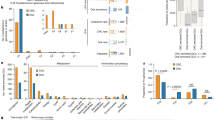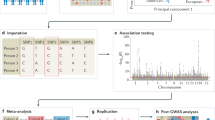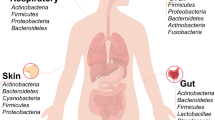Abstract
Dysbiosis, departure of the gut microbiome from a healthy state, has been suggested to be a powerful biomarker of disease incidence and progression1,2,3. Diagnostic applications have been proposed for inflammatory bowel disease diagnosis and prognosis4, colorectal cancer prescreening5 and therapeutic choices in melanoma6. Noninvasive sampling could facilitate large-scale public health applications, including early diagnosis and risk assessment in metabolic7 and cardiovascular diseases8. To understand the generalizability of microbiota-based diagnostic models of metabolic disease, we characterized the gut microbiota of 7,009 individuals from 14 districts within 1 province in China. Among phenotypes, host location showed the strongest associations with microbiota variations. Microbiota-based metabolic disease models developed in one location failed when used elsewhere, suggesting that such models cannot be extrapolated. Interpolated models performed much better, especially in diseases with obvious microbiota-related characteristics. Interpolation efficiency decreased as geographic scale increased, indicating a need to build localized baseline and disease models to predict metabolic risks.
This is a preview of subscription content, access via your institution
Access options
Access Nature and 54 other Nature Portfolio journals
Get Nature+, our best-value online-access subscription
$29.99 / 30 days
cancel any time
Subscribe to this journal
Receive 12 print issues and online access
$209.00 per year
only $17.42 per issue
Buy this article
- Purchase on Springer Link
- Instant access to full article PDF
Prices may be subject to local taxes which are calculated during checkout



Similar content being viewed by others
Change history
24 September 2018
In the version of this article originally published, in the sentence “Applying the same approach to obesity (Fig. 2b), MetS (Fig. 2c) and fatty liver (Fig. 2d) yielded similar results,” two figure panels were cited incorrectly. The data for obesity are in Fig. 2c, and the data for MetS are in Fig. 2b. The sentence has been updated with the correct citations in the print, PDF and HTML versions of the article.
References
Lynch, S. V. & Pedersen, O. The human intestinal microbiome in health and disease. N. Engl. J. Med. 375, 2369–2379 (2016).
Gilbert, J. A. et al. Microbiome-wide association studies link dynamic microbial consortia to disease. Nature 535, 94–103 (2016).
Gilbert, J. A. et al. Current understanding of the human microbiome. Nat. Med. 24, 392–400 (2018).
Dubinsky, M. & Braun, J. Diagnostic and prognostic microbial biomarkers in inflammatory bowel diseases. Gastroenterology 149, 1265–1274.e3 (2015).
Konstantinov, S. R., Kuipers, E. J. & Peppelenbosch, M. P. Functional genomic analyses of the gut microbiota for CRC screening. Nat. Rev. Gastroenterol. Hepatol. 10, 741–745 (2013).
Routy, B. et al. Gut microbiome influences efficacy of PD-1-based immunotherapy against epithelial tumors. Science 359, 91–97 (2018).
Bouter, K. E., van Raalte, D. H., Groen, A. K. & Nieuwdorp, M. Role of the gut microbiome in the pathogenesis of obesity and obesity-related metabolic dysfunction. Gastroenterology 152, 1671–1678 (2017).
Tang, W. H. et al. Intestinal microbial metabolism of phosphatidylcholine and cardiovascular risk. N. Engl. J. Med. 368, 1575–1584 (2013).
Graham, C., Mullen, A. & Whelan, K. Obesity and the gastrointestinal microbiota: a review of associations and mechanisms. Nutr. Rev. 73, 376–385 (2015).
Wieland, A., Frank, D. N., Harnke, B. & Bambha, K. Systematic review: microbial dysbiosis and nonalcoholic fatty liver disease. Aliment. Pharmacol. Ther. 42, 1051–1063 (2015).
Forslund, K. et al. Disentangling type 2 diabetes and metformin treatment signatures in the human gut microbiota. Nature 528, 262–266 (2015).
Yatsunenko, T. et al. Human gut microbiome viewed across age and geography. Nature 486, 222–227 (2012).
Martínez, I. et al. The gut microbiota of rural papua new guineans: composition, diversity patterns, and ecological processes. Cell Reports 11, 527–538 (2015).
Gupta, V. K., Paul, S. & Dutta, C. Geography, ethnicity or subsistence-specific variations in human microbiome composition and diversity. Front. Microbiol. 8, 1162 (2017).
Winglee, K. et al. Recent urbanization in China is correlated with a Westernized microbiome encoding increased virulence and antibiotic resistance genes. Microbiome 5, 121 (2017).
Costea, P. I. et al. Towards standards for human fecal sample processing in metagenomic studies. Nat. Biotechnol. 35, 1069–1076 (2017).
Falony, G. et al. Population-level analysis of gut microbiome variation. Science 352, 560–564 (2016).
Caporaso, J. G. et al. QIIME allows analysis of high-throughput community sequencing data. Nat. Methods 7, 335–336 (2010).
Zhernakova, A. et al. Population-based metagenomics analysis reveals markers for gut microbiome composition and diversity. Science 352, 565–569 (2016).
Anderson, M. J. & Walsh, D. C. I. PERMANOVA, ANOSIM, and the Mantel test in the face of heterogeneous dispersions: what null hypothesis are you testing? Ecol. Monogr. 83, 557–574 (2013).
Zhou, Y. et al. Gut microbiota offers universal biomarkers across ethnicity in inflammatory bowel disease diagnosis and infliximab response prediction. mSystems 3, e00188–e00117 (2018).
Yu, J. et al. Metagenomic analysis of faecal microbiome as a tool towards targeted non-invasive biomarkers for colorectal cancer. Gut 66, 70–78 (2017).
Walters, W. A., Xu, Z. & Knight, R. Meta-analyses of human gut microbes associated with obesity and IBD. FEBS Lett. 588, 4223–4233 (2014).
McDonald, D. et al. American Gut: an open platform for citizen science microbiome research. mSystems 3, e00031–18 (2018).
Stagaman, K. et al. Market integration predicts human gut microbiome attributes across a gradient of economic development. mSystems 3, e00122–17 (2018).
Costello, E. K., Stagaman, K., Dethlefsen, L., Bohannan, B. J. & Relman, D. A. The application of ecological theory toward an understanding of the human microbiome. Science 336, 1255–1262 (2012).
Liao, M. et al. Comparative analyses of fecal microbiota in Chinese isolated Yao population, minority Zhuang and rural Han by 16sRNA sequencing. Sci. Rep. 8, 1142 (2018).
Walters, W. et al. Improved bacterial 16S rRNA Gene (V4 and V4-5) and fungal internal transcribed spacer marker gene primers for microbial community surveys. mSystems 1, e00009–e00015 (2015).
Frank, D. N. BARCRAWL and BARTAB: software tools for the design and implementation of barcoded primers for highly multiplexed DNA sequencing. BMC Bioinformatics 10, 362 (2009).
McDonald, D., Birmingham, A. & Knight, R. Context and the human microbiome. Microbiome 3, 52 (2015).
Edgar, R. C. Search and clustering orders of magnitude faster than BLAST. Bioinformatics 26, 2460–2461 (2010).
McDonald, D. et al. An improved Greengenes taxonomy with explicit ranks for ecological and evolutionary analyses of bacteria and archaea. ISME. J. 6, 610–618 (2012).
He, Y. et al. Stability of operational taxonomic units: an important but neglected property for analyzing microbial diversity. Microbiome 3, 20 (2015).
McDonald, D. et al. The Biological Observation Matrix (BIOM) format or: how I learned to stop worrying and love the ome-ome. Gigascience 1, 7 (2012).
Morgan, X. C. et al. Dysfunction of the intestinal microbiome in inflammatory bowel disease and treatment. Genome. Biol. 13, R79 (2012).
Xie, H. et al. Shotgun metagenomics of 250 adult twins reveals genetic and environmental impacts on the gut microbiome. Cell Syst. 3, 572–584 (2016).
Lim, M. Y. et al. The effect of heritability and host genetics on the gut microbiota and metabolic syndrome. Gut 66, 1031–1038 (2017).
Acknowledgements
We acknowledge the contributions of the 308 local CDC investigators and registered nurses for their help with collection point maintenance and metadata and stool sample collection. We thank all volunteers who participated in this project. This study was supported by the National Projects of Major Infectious Disease Control and Prevention (2017ZX10103011 (H.W.Z.)), National Natural Science Foundation of China (NSFC31570497 (H.W.Z.), 31322003 (H.W.Z.), and 81671171 (J.Y.)), China Postdoctoral Science Foundation (C1090132 (Y.H.)) and the Science and Technology Planning Project of Guangdong Province, China (2015A030401055 (W.W.)).
Author information
Authors and Affiliations
Contributions
Y.H., W.W., W.-J.M. and H.-W.Z. designed the study; W.W., C.-Z.H., Z.-H.C, G.-Y.J., Y.-J.X. and W.-J.M. organized data collection and trained local CDC investigators; M.-X.C., Z.-D.-X.Z., P.M., X.-J.C., Z.-H.R., L.-Y.L. and N.Y. processed the samples; Y.H., H.-M.Z., P.L., H.-F.S., X.W., C.-B.W., P.C., J.Y. and H.-W.Z. analyzed the data; Y.H., D.M., W.-J.M., R.K. and H.-W.Z. drafted the manuscript; and R.K. and J.R. offered advice regarding the design of the study, data analysis and manuscript writing.
Corresponding authors
Ethics declarations
Competing interests
L.-Y.L., X.W. and C.-B.W. are employees of Shenzhen Fun-Poo Biotech Co., LTD.
Additional information
Publisher's note: Springer Nature remains neutral with regard to jurisdictional claims in published maps and institutional affiliations.
Supplementary information
Supplementary Text and Figures
Supplementary Figures 1–14
Supplementary Tables
Supplementary Tables 1–14
Rights and permissions
About this article
Cite this article
He, Y., Wu, W., Zheng, HM. et al. Regional variation limits applications of healthy gut microbiome reference ranges and disease models. Nat Med 24, 1532–1535 (2018). https://doi.org/10.1038/s41591-018-0164-x
Received:
Accepted:
Published:
Issue Date:
DOI: https://doi.org/10.1038/s41591-018-0164-x
This article is cited by
-
Integrative metagenomic analysis reveals distinct gut microbial signatures related to obesity
BMC Microbiology (2024)
-
Microbial-derived imidazole propionate links the heart failure-associated microbiome alterations to disease severity
Genome Medicine (2024)
-
In-depth metaproteomics analysis of tongue coating for gastric cancer: a multicenter diagnostic research study
Microbiome (2024)
-
The microbial landscape of colorectal cancer
Nature Reviews Microbiology (2024)
-
A gut microbial signature for combination immune checkpoint blockade across cancer types
Nature Medicine (2024)



